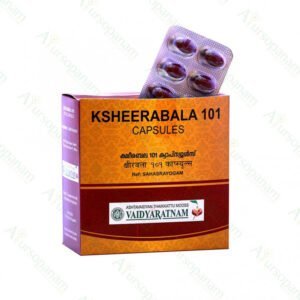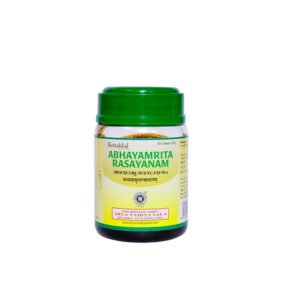Kooshmanda is the Sanskrit term for Ash gourd (Benincasa hispida), which is acclaimed by Ayurveda for its capacity to balance Vata and Kapha elements in the body. Kushmanda Rasayana works at multiple levels it clears metabolic pathways, directly nourishes the tissues and expels metabolic toxins.
The avaleha combination is palatable due to its sweet jaggery base. Kushmanda Rasayana is beneficial in improving health and vitality, especially in children with loss of appetite.
Features & Benefits
- A nourishing preparation of Kooshmanda or Ash gourd processed with appetite-stimulating and digestive drugs.
- Kooshmanda has Sngidha (unctous), Seeta (cooling) and Medhya (intellect promoting) gunas. Kushmanda Rasayana is particularly beneficial for wholistic nourishment and development in children.
- It improves respiratory health. Clears the respiratory tract and strengthens the chest muscles.
- Kushmanda Rasayana is also beneficial in the treatment of individuals emaciated by chronic cough. It is routinely used in the convalescent stage to regain lost health and vitality.
Dosage and Instructions
Adult: 5-10 gms Kushmanda Rasayana once or twice daily, as recommended by the Physician.Child: 3-5 gms Kushmanda Rasayana once or twice daily, as recommended by the Physician.
Key Ingredients
Sarkara (Saccharum officinarum)
Commonly known as the sugarcane. Its roots are used for the therapeutic purposes. Having properties aphrodisiac (arouse sexual desires), laxative, cooling, demulcent, antiseptic, and tonic. Sugarcane juice is very useful in jaundice conditions.
Pippali (Piper longum)
Pippali is known as Tridoshic herb as it suits all body types. Regular consumption of Pippali in suggested quantity can help you to immune your body to quiet an extent. Pippali has anti-microbial, anti-inflammatory activity. Consumption of Pippali is said to exhibit anti-spasmodic action and hypoglycaemic effect which is believed to lower blood sugar level. It is also reported to be antagonist in respiratory depression. Also due to its cooling post-digestive effect consumption of Pippali is considered as a safe and effective option to avoid all sorts of digestive disorders.
Shunti(Zingiber officinale)
Due to its strong flavor, Ginger is an essential ingredient in many Asian cuisines. Its therapeutic benefits have been recorded in Ayurvedic and Traditional Chinese Medicine. Ginger is a potent anti-nauseatic and is beneficial in treating upset stomach.Gingerol and shogaol, active components of Ginger, suppress gastric contractions. Both the fresh and dried rhizomes of Ginger suppress gastric secretion and reduce vomiting. The compounds 6-gingerol and 6-shogaol have a number of pharmacological properties, including antipyretic, analgesic, antitussive and hypotensive properties.
Jeerakam (Cuminum cyminum)
Also called Cumin Seeds in English and botanically, Cuminum Cyminum is an Indian Spice as well as an Ayurvedic medicine used for several diseases of the digestive, respiratory, circulatory, and reproductive system.
Ela (Elettaria cardomum)
Commonly called Elaichi, it has a very good anti-bacterial and anti-fungal properties and helps in reducing inflammation. Cardamom is often given the epithet Queen of Spices as it is used to flavor food in many countries. in addition, the herb has several health benefits. The German Commission E has indicated the use of Cardamom in dyspepsia and as a cholagogue, which promotes bile discharge from the system. The herb is also helpful in treating gum and teeth infections, throat congestion and kidney disorders.
Twak (Cinnamom verum)
Cinammon is used for Neurological disorders, Cardiovascular diseases, Oxidative stress, inflammatory disorders, Diabetes, Microbial infections, Cancer and other conditions extensively in Ayurveda.
Maricha (Piper nigrum)
Black pepper is native to the Western Ghats of India. It is cultivated for its fruit, which is widely used as spice and in traditional Indian medicine preparation. Black pepper is an appetizer and carminative commonly used in the treatment of digestive system related complaints like dyspepsia, indigestion, flatulence, nausea, diarrhea and colic pain. in the respiratory system it acts like expectorant used in cough, cold and chest congestion. Externally used as an analgesic and in vitiligo it stimulates the production of pigments.
















































Ratings & Customer Reviews
Reviews
There are no reviews yet.